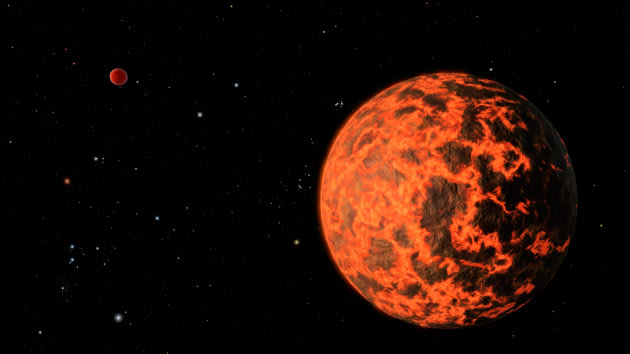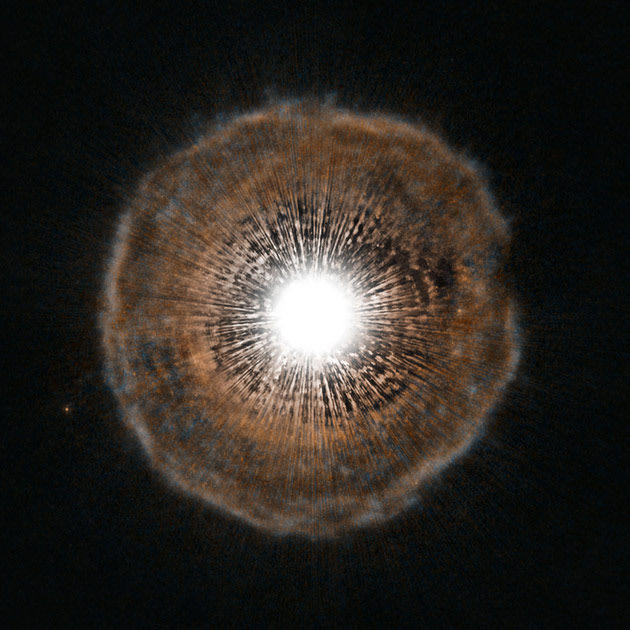This NASA image obtained July 11, 2012 shows an artist's rendering which illustrates the evaporation of HD 189733b's atmosphere in response to a powerful eruption from its host star. The exoplanet is a gas giant similar to Jupiter, but about 14 percent larger and more massive. The planet circles its star at a distance of only 3 million miles, or about 30 times closer than Earth's distance from the sun. Its star, named HD 189733A, is about 80 percent the size and mass of our sun. Exoplanet HD 189733b lies so near its star that it completes an orbit every 2.2 days. In late 2011, NASA's Hubble Space Telescope found that the planet's upper atmosphere was streaming away at speeds exceeding 300,000 mph. Just before the Hubble observation, NASA's Swift detected the star blasting out a strong X-ray flare, one powerful enough to blow away part of the planet's atmosphere.
An alien world just two-thirds the size of Earth - one of the smallest on record - detected by NASA's Spitzer Space Telescope is seen in this NASA artist's illustration released by NASA on July 18, 2012. The exoplanet candidate, known as UCF-1.01, orbits a star called GJ 436, which is located a mere 33 light-years away. UCF-1.01 might be the nearest world to our solar system that is smaller than our home planet. Evidence for UCF-1.01 turned up when astronomers were studying a known, Neptune-sized exoplanet, called GJ 436b, seen in the background in this image. The identification of nearby small planets may lead to their characterization using future instruments. In this way, worlds like UCF-1.01 might serve as stepping stones to one day finding a habitable, Earth-like exoplanet.
This NASA image released July 11, 2012 shows a computer-simulated image of gas from a star that is ripped apart by tidal forces as it falls into a black hole. Some of the gas also is being ejected at high speeds into space. Using observations from telescopes in space and on the ground, astronomers gathered the most direct evidence yet for this violent process: a supermassive black hole shredding a star that wandered too close. NASA's orbiting Galaxy Evolution Explorer (GALEX) and the Pan-STARRS1 telescope on the summit of Haleakala in Hawaii were used to help to identify the stellar remains. A flare in ultraviolet and optical light revealed gas falling into the black hole as well as helium-rich gas that was expelled from the system. When the star is torn apart, some of the material falls into the black hole, while the rest is ejected at high speeds. The flare and its properties provide a signature of this scenario and give unprecedented details about the stellar victim.To completely rule out the possibility of an active nucleus flaring up in the galaxy instead of a star being torn apart, the team used NASA's Chandra X-ray Observatory to study the hot gas. Chandra showed that the characteristics of the gas didn't match those from an active galactic nucleus.The galaxy where the supermassive black hole ripped apart the passing star in known as PS1-10jh and is located about 2.7 billion light years from Earth.
Astronomers estimate the black hole in PS1-10jh has a mass of several
A true color image of Titan's colorful south polar vortex captured by NASA's Cassini spacecraft before a distant flyby of Saturn's moon Titan on June 27, 2012, shows a south polar vortex, or a mass of swirling gas, around the pole in the atmosphere of the moon. The south pole of Titan which is 3,200 miles (5,150 km) across is near the center of the view. The formation of the vortex at Titan's south pole may be related to the coming southern winter and the start of what will be a south polar hood. These new, more detailed images are only possible because of Cassini's newly inclined orbits, which are the next phase of Cassini Solstice Mission. Previously, Cassini was orbiting in the equatorial plane of the planet, and the imaging team's images of the polar vortex between late March and mid-May were taken from over Titan's equator. Scientists think these new images show open cell convection. In open cells, air sinks in the center of the cell and rises at the edge, forming clouds at cell edges. REUTERS/NASA/JPL-Caltech/Space Science Institute/Handout
A NASA/ESA Hubble Space Telescope image released on July 7, 2012 shows U Camelopardalis, or U Cam for short, a star nearing the end of its life located in the constellation of Camelopardalis (The Giraffe), near the North Celestial Pole. As it begins to run low on fuel, it is becoming unstable. Every few thousand years, it coughs out a nearly spherical shell of gas as a layer of helium around its core begins to fuse. The gas ejected in the star's latest eruption is clearly visible in this picture as a faint bubble of gas surrounding the star. The shell of gas, which is both much larger and much fainter than its parent star, is visible in intricate detail in Hubble's portrait. While phenomena that occur at the ends of stars' lives are often quite irregular and unstable, the shell of gas expelled from U Cam is almost perfectly spherical. The image was produced with the High Resolution Channel of the Advanced Camera for Surveys. REUTERS/ESA/Hubble, NASA and H. Olofsson/Handout
An alien world just two-thirds the size of Earth - one of the smallest on record - detected by NASA's Spitzer Space Telescope is seen in this NASA artist's illustration released by NASA on July 18, 2012. The exoplanet candidate, known as UCF-1.01, orbits a star called GJ 436, which is located a mere 33 light-years away. UCF-1.01 might be the nearest world to our solar system that is smaller than our home planet. Evidence for UCF-1.01 turned up when astronomers were studying a known, Neptune-sized exoplanet, called GJ 436b, seen in the background in this image. The identification of nearby small planets may lead to their characterization using future instruments. In this way, worlds like UCF-1.01 might serve as stepping stones to one day finding a habitable, Earth-like exoplanet.
This NASA image released July 11, 2012 shows a computer-simulated image of gas from a star that is ripped apart by tidal forces as it falls into a black hole. Some of the gas also is being ejected at high speeds into space. Using observations from telescopes in space and on the ground, astronomers gathered the most direct evidence yet for this violent process: a supermassive black hole shredding a star that wandered too close. NASA's orbiting Galaxy Evolution Explorer (GALEX) and the Pan-STARRS1 telescope on the summit of Haleakala in Hawaii were used to help to identify the stellar remains. A flare in ultraviolet and optical light revealed gas falling into the black hole as well as helium-rich gas that was expelled from the system. When the star is torn apart, some of the material falls into the black hole, while the rest is ejected at high speeds. The flare and its properties provide a signature of this scenario and give unprecedented details about the stellar victim.To completely rule out the possibility of an active nucleus flaring up in the galaxy instead of a star being torn apart, the team used NASA's Chandra X-ray Observatory to study the hot gas. Chandra showed that the characteristics of the gas didn't match those from an active galactic nucleus.The galaxy where the supermassive black hole ripped apart the passing star in known as PS1-10jh and is located about 2.7 billion light years from Earth.
Astronomers estimate the black hole in PS1-10jh has a mass of several
A true color image of Titan's colorful south polar vortex captured by NASA's Cassini spacecraft before a distant flyby of Saturn's moon Titan on June 27, 2012, shows a south polar vortex, or a mass of swirling gas, around the pole in the atmosphere of the moon. The south pole of Titan which is 3,200 miles (5,150 km) across is near the center of the view. The formation of the vortex at Titan's south pole may be related to the coming southern winter and the start of what will be a south polar hood. These new, more detailed images are only possible because of Cassini's newly inclined orbits, which are the next phase of Cassini Solstice Mission. Previously, Cassini was orbiting in the equatorial plane of the planet, and the imaging team's images of the polar vortex between late March and mid-May were taken from over Titan's equator. Scientists think these new images show open cell convection. In open cells, air sinks in the center of the cell and rises at the edge, forming clouds at cell edges. REUTERS/NASA/JPL-Caltech/Space Science Institute/Handout
A NASA/ESA Hubble Space Telescope image released on July 7, 2012 shows U Camelopardalis, or U Cam for short, a star nearing the end of its life located in the constellation of Camelopardalis (The Giraffe), near the North Celestial Pole. As it begins to run low on fuel, it is becoming unstable. Every few thousand years, it coughs out a nearly spherical shell of gas as a layer of helium around its core begins to fuse. The gas ejected in the star's latest eruption is clearly visible in this picture as a faint bubble of gas surrounding the star. The shell of gas, which is both much larger and much fainter than its parent star, is visible in intricate detail in Hubble's portrait. While phenomena that occur at the ends of stars' lives are often quite irregular and unstable, the shell of gas expelled from U Cam is almost perfectly spherical. The image was produced with the High Resolution Channel of the Advanced Camera for Surveys. REUTERS/ESA/Hubble, NASA and H. Olofsson/Handout













0 comments:
Post a Comment